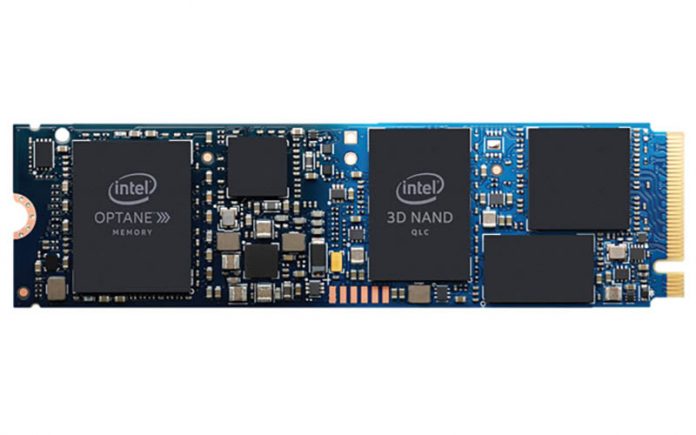Intel’s storage division is introducing one of the most intriguing products you could imagine. The Intel Optane Memory H10 combines up to 1TB of QLC 3D NAND with up to 32GB of Optane memory onto a single M.2. The benefits are obvious, Intel is able to provide a single M.2 solution that has both fast and relatively durable Intel 3D XPoint together with capacity optimized QLC 3D NAND.
Intel Optane Memory H10
We did not get a huge amount of detail around the Intel Optane Memory H10. Instead, we got slim details. One that we found intriguing, this is not shipping today. Instead, it will be shipping in the spring of 2019.
Capacities for the devices will be:
- 16GB (Optane) + 256GB (QLC);
- 32GB (Optane) +512GB (QLC); and
- 32GB (Optane) + 1TB (QLC)
Our Editor-in-Chief, Patrick, asked a few clarifying questions around the Intel Optane Memory H10 products:
STH: Is the Intel Optane Memory H10 seen as two drives, or is the Optane being used as a cache for the NAND?
Intel: In OEM systems, the Intel Optane Memory H10 will be preconfigured to look like a single device.
STH: Are they all M.2 2280 or are the larger capacities bigger?
Intel: They’re all M.2 2280.
Final Words
There are two ways in which this product could work. It could be a highly integrated single device or two devices that share a PCB.
If it is a highly integrated device, this has major implications. One could have NVMe SSDs with Intel Optane Persistent Memory acting as a read/ write buffer at the higher-end. In the low-end enterprise space this may be intriguing but for higher-end scenarios, we will likely still see dedicated Optane devices or upcoming Intel Optane DC Persistent Memory Modules for write caches. Still, if Intel is pulling this off, which seems unlikely given our Q&A, then it could make for single drives that use NAND and Optane managed by an Intel controller.
On the other hand, the Intel Optane Memory H10 could look like two SSDs, each on a PCIe 3.0 x2 interface. That may use less power than a dedicated PCIe switched device. If this is going into a mobile form factor, less power consumption will be a concern. If that is the case, then the comment that the “Intel Optane Memory H10 will be preconfigured to look like a single device” seems to indicate that it will look like two devices.
For those of our readers who may have wanted to put both a 3D NAND capacity SSD and an Intel Optane Memory module, perhaps for read cache/ write cache, this may have the ability to fit that role, especially in embedded platforms with a single M.2 2280 slot.




I Seriously hope this get caught on and Optane will be low price enough as replacement for DRAM in SSD. The low memory running and paging is current doing 200GB+ per day writing to my SSD. In other words, it is actively killing it.
It would be nice if I had Optane just to page it into.
HPE is doing something similar with 3PAR and Optane. Instead of going NVME for drives, the idea is to use Optane to cache the system, and let the underlying SAS SSD deal with shuffling data in and out of Optane. HPE apparently found little performance difference between using Optane as the front-end to SAS SSD versus going all NVME without caching.
This drive, could, bear that out. Inbound writes to Optane, and frequently used on the read on the Optane. QLC NAND to pull up the rear. Not a fan of QLC, but, the Optane may mask a lot of it’s issues.
I’m super interested in the H10 but only if seen as one device.
Your right on the embedded platforms. We’ve deployed hundreds of Supermicro X10SDV’s with a single x4 slot. If it was a single drive that managed caching so we didn’t have to think about it we’d deploy them no questions.
What’s useless is if they’re x2 + x2 expecting bifurcation AND they need Windoes. For RST
While there are use scenarios where the H10 is best seen as an integrated device, I don’t see this as necessary to its success. For laptops with limited memory, using Optane for /swap (and /tmp etc.) would be an effective way to extend the useful life of QLC storage. In low-end servers, Optane could be used for SLOG and L2ARC. In high-end servers where large numbers of H10 devices might exist, managing separate Optane and QLC “devices” would be wearisome and best handled with (even) better dedicated higher performance devices.
I am beginning to think that Samsung has only to announce 2880 Z NAND SKUs for this to be overlooked.
What Intel has to do is bring the Scale-MP driver into the light, and make Optane addressable as multiple 16GB drives and the NAND configurable for capacity and over provision like Micron. This could be a design win lock in if on cpu die switches are dialled in to extract everything possible.